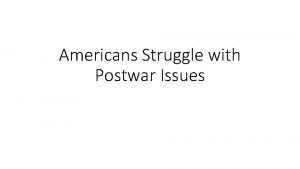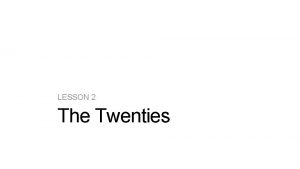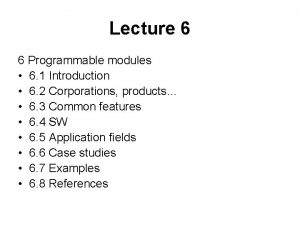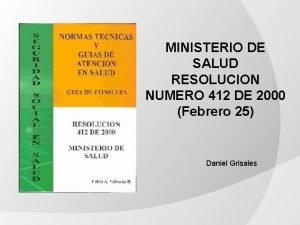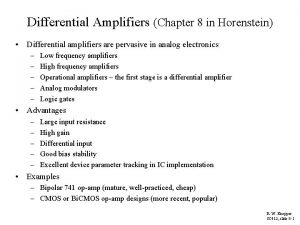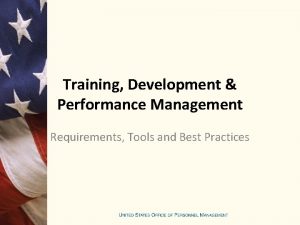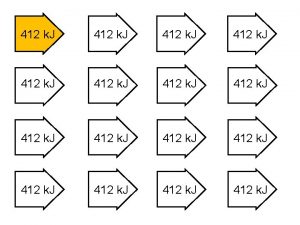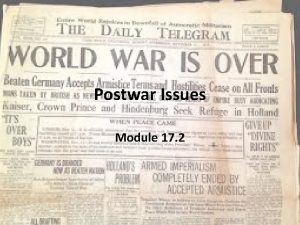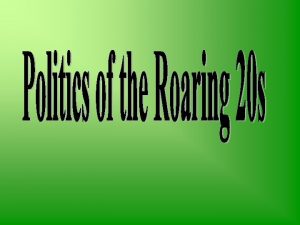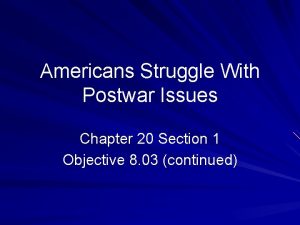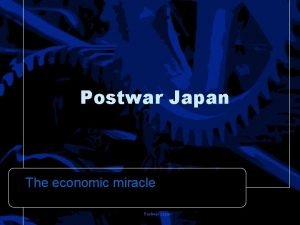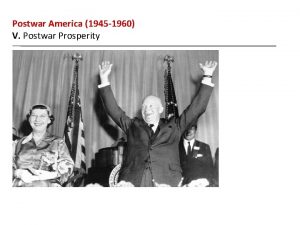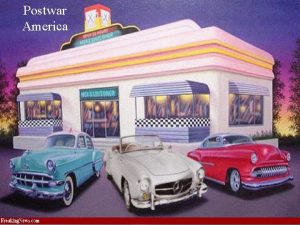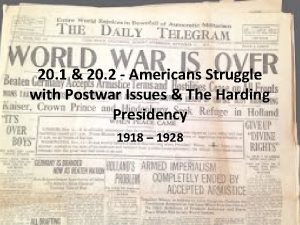AMERICANS STRUGGLE WITH POSTWAR ISSUES p 412 418














- Slides: 14

AMERICANS STRUGGLE WITH POSTWAR ISSUES p. 412 -418

Objectives • Summarize the reaction in the United States to the perceived threat of communism • Analyze the causes and effects of the quota system in the United States • Describe some of the postwar conflicts between labor and management

POSTWAR TRENDS Nativism • Prejudice against foreign -born people Isolationism • A policy of pulling away from involvement in world affairs

FEAR OF COMMUNISM The Red Scare Communism • An economic government ruled by a dictatorship • Karl Marx’s version of extreme socialism • No private property • Government owns all factors of production Lenin’s Bolsheviks established themselves in the post revolution Russia Communist Party in the United States 70, 000 strong A number of bombs were mailed to government and business leaders Americans began to fear a Communist take over

FEAR OF COMMUNISM The Palmer Raids A. Mitchell Palmer • U. S. Attorney General J. Edgar Hoover • Appointed by Palmer as special assistant • Started to hunt down suspected • Communists • Socialists • Anarchists • People who opposed any form of government Homes & offices invaded Civil Rights Trampl Suspects jailed without legal council ed 100 s of foreign-born radicals were deported Palmer No evidence of revolutionary conspiracy ’s Raids Fail Many thought Palmer has aims at the White House and was using the raids as a jumping off point

FEAR OF COMMUNISM Sacco and Vanzetti Bartolo meo Vanzetti Nicola Sacco • Shoe maker • Fish peddler Avoided the draft Anarchists May 1920 – arrested and charged with murder of a factory paymaster and guard in Massachusetts Witnesses said the criminals appeared to Italian Both proclaimed their innocence and had alibis Evidence was circumstantial - pointing indirectly toward someone's guilt but not conclusively proving it. Judge maid prejudicial remarks - harmful to someone or something Found guilty and sentenced to death

LIMITING IMMIGRATION “Keep America for Americans” New Southern and Eastern Europe Immigran Willing to work for low wages in ts tough jobs After WWI fewer unskilled workers were needed Immigrants were seen as taking these jobs from Americans Postwar labor disputes were often immigrant anarchists and socialist – secret communists

LIMITING IMMIGRATION The Klan Rises Again Ku Klux Klan • • • Devoted to 100% Americanism 1924 – 4. 5 million Keep African-American “in their place” Destroying saloons Breaking up unions Driving out • Catholics • Jews • Foreign born people

LIMITING IMMIGRATION The Quota System 19191921 Immigration had grown 600% 140, 000 -805, 000 Emergency Quota Act of 1921 Quota System Established a maximum number of people who could enter the United States from each foreign country

LIMITING IMMIGRATION The Quota System (cont. ) Each European country was limited to 2% of the number of its nationals living in the United States in 1890 Later was shifted to 1920 Law limited the total number of persons admitted to 150, 000 The quota system did not effect the Western Hemisphere • 500, 000 Mexicans and Canadians came to America

A TIME OF LABOR UNREST The Boston Police Strike The Steel Mill Strike Had not had a raise since the start of the war U. S. Steel Corporation Could not unionize Those reps who asked for a raise were fired Massachusetts governor Calvin Coolidge called out the Nation Guard Strike ends and new policemen are hired • Shorter working hours • Union recognition • Collective bargaining • is a process of negotiations between employers and a group of employees aimed at reaching agreements to regulate working conditions. 300, 000 workers walk off the job • Strikebreakers are brought in • Propaganda is used against union Exposing of harsh working conditions finally helps the steel companies to an eight-hour day

A TIME OF LABOR UNREST The Coal Miners’ Strike United Mine Workers of Organized since 1890 America John L. Lewis Leader of United Mine Workers of America Organized a strike in 1919 to protest low wages and long hours Attorney General Palmer has court order send workers back Mines stayed closed another month President Wilson appoints and arbitrator • an independent person or body officially appointed to settle a dispute Coal miners receive 27% pay increase Lewis becomes a national hero

A TIME OF LABOR UNREST Labor Movement Loses Appeal Sharp drop off in union membership • 5 million - 3. 5 million Several reasons why • • Immigrant work force Organization problems Individualism Exclusion of African-Americans Only 82, 000 African-Americans were apart of a union in 1929 • 1% of the African-American population • 3% of the white population were in unions A. Phillip Randolph • Founded the Brotherhood of Sleeping Car Porter

2. How did Americans react to the perceived threat of Communism? 3. Why did the United States limit immigration? 4 How did anti-immigration sentiment strengthen the Ku Klux Klan’s attack on minorities? 5. What was the quota system? 6. Why did conflict between labor and management increase after WWI?
